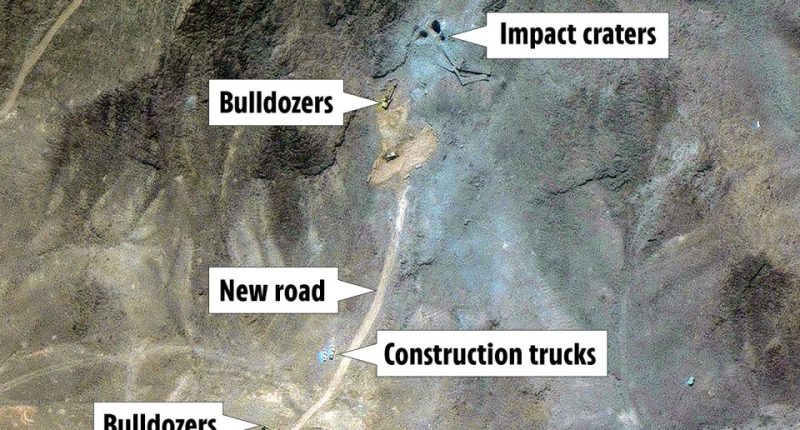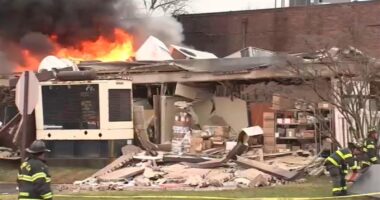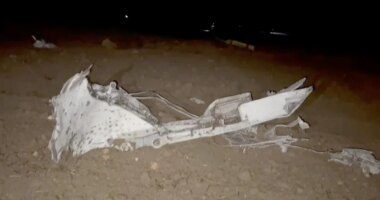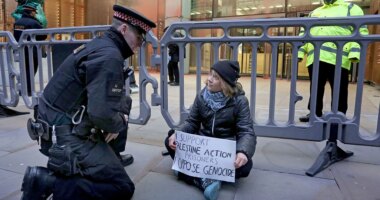Share this @internewscast.com
SATELLITE pictures have emerged showing fresh construction work at Iran’s top nuclear facility after it was bombed by the US.
Tehran has acknowledged that its Fordow nuclear facility, a crucial component of its nuclear ambitions, suffered “significant damage” following the US deployment of over a dozen bunker buster bombs.

But the UN’s top nuclear watchdog International Atomic Energy Agency (IAEA) warned Iran could start enriching uranium again within just months.
Latest satellite imagery appears to show construction work at the Fordow Nuclear Enrichment facility in Qom, near Tehran.
Heavy earthmoving equipment can be seen working near the impact craters caused by US GBU-57 bunker-buster bombs.
Excavators and cranes can also be seen working, while more construction trucks are visible on roads leading to the impact points at the site.
There is now a new access road visible between the site’s northern tunnel entrance and one of the impact craters. This comes after Israel claimed that its air force targeted Fordow to impede access to the site.
According to David Albright, an expert in US weaponry, he noted in his analysis that Iran might be working on filling the craters, conducting damage assessments, and taking radiological samples.
It comes after Trump claimed that the strikes had “obliterated” Iran’s nuclear capabilities and “completely destroyed” the Fordow enrichment plant.
In an interview with Fox News, the US president said the Fordow enrichment site was “just thousands of tons of rock” and that “the whole place was just destroyed.” He said the strikes had landed at “the perfect time”.
He added: “We went in, we destroyed their nuclear capability and we stopped. It was a beautiful thing and they couldn’t have gone on much further.”
The president also slammed leaked preliminary findings from the Pentagon’s Defence Intelligence Agency that said the damage was not severe enough to destroy its nuclear programme.
Tehran has admitted that Operation Midnight Hammer and the joint Israeli attacks did cause “excessive and serious” damage.
However, doubts remain about whether Iran quietly removed 408.6 kgs of uranium from its most sensitive sites before the strikes – potentially hiding nuclear material elsewhere in the country.
The uranium in question is enriched to 60 per cent – way above levels for civilian usage but slightly below weapons grade.
That material, if further refined to 90 per cent, would theoretically be sufficient to produce more than nine nuclear bombs.
Trump dismissed such speculation, saying: “Nothing was taken out… too dangerous, and very heavy and hard to move!”
He added that satellite images showed trucks at the site only because Iranian crews were attempting to shield the facility with concrete.
But even with a ceasefire being agreed upon, Trump made it clear he would “absolutely” consider bombing Iran again if it was ever needed.
He told reporters in the White House he would “without question” attack the country if US intelligence pointed towards Iran enriching uranium to concerning levels.
Meanwhile, IAEA chief Rafael Grossi says Iran likely will be able to begin to produce enriched uranium “in a matter of months,” despite the damage.
He said: “They can have, you know, in a matter of months, I would say, a few cascades of centrifuges spinning and producing enriched uranium, or less than that.”
Iranian nuke sites bombed by US
By Sayan Bose, Foreign News Reporter
Fordow enrichment facility
Iran’s nuclear facility at Fordow is located some 60 miles southwest of Tehran, which hosts centrifuge cascades.
Its construction began at least in 2007, according to the IAEA, although Iran only informed the UN nuclear watchdog about the facility in 2009 after the US and allied Western intelligence agencies became aware of its existence.
Buried under a mountain and protected by anti-aircraft batteries, Fordow appears designed to withstand airstrikes.
Military experts have said it could likely only be targeted by bunker buster bombs, a term for bombs that are designed to penetrate deep below the surface before exploding, such as the latest GBU-57 A/B Massive Ordnance Penetrator bomb in the American arsenal.
The roughly 30,000-pound precision-guided bomb is designed to attack deeply buried and hardened bunkers and tunnels.
The US has only configured and programmed its B-2 Spirit stealth bomber to deliver that bomb, according to the Air Force.
The B-2 is only flown by the Air Force, and is produced by Northrop Grumman, meaning that Washington would have to be involved in such an operation.
Natanz enrichment facility
Iran’s nuclear facility at Natanz, located some 135 miles southeast of Tehran, is the country’s main enrichment site and had already been targeted by Israeli airstrikes.
Uranium had been enriched to up to 60% purity at the site a mildly radioactive level but a short step away from weapons grade before Israel destroyed the aboveground part of the facility, according to the UN’s nuclear watchdog, the International Atomic Energy Agency.
Another part of the facility on Iran’s Central Plateau is underground to defend against potential airstrikes.
It operates multiple cascades, or groups of centrifuges working together to more quickly enrich uranium.
The IAEA has said it believes that most, if not all, of these centrifuges were destroyed by an Israeli strike that cut off power to the site.
The IAEA said those strikes caused contamination only at the site itself, not the surrounding area.
Iran also is burrowing into the Kh-e Kolang Gaz L, or Pickax Mountain, which is just beyond Natanzs southern fencing.
Natanz has been targeted by the Stuxnet virus, believed to be an Israeli and American creation, which destroyed Iranian centrifuges.
Two separate attacks, attributed to Israel, also have struck the facility.
Isfahan Nuclear Technology Centre
The facility in Isfahan, some 215 miles southeast of Tehran, employs thousands of nuclear scientists.
It is also home to three Chinese research reactors and laboratories associated with the country’s atomic program.
Israel has struck buildings at the Isfahan nuclear site, among them a uranium conversion facility.
The IAEA said there has been no sign of increased radiation at the site.
Iran has several other sites in its nuclear program that were not announced as targets in the US strikes
Bushehr nuclear power station – Iran’s only commercial nuclear power plant is in Bushehr on the Persian Gulf, some 465 miles south of Tehran.
Iran is building two other reactors like it at the site.
Bushehr is fueled by uranium produced in Russia, not Iran, and is monitored by the IAEA.
Arak plant – The Arak heavy water reactor is 155 miles southwest of Tehran.
Heavy water helps cool nuclear reactors, but it produces plutonium as a byproduct that can potentially be used in nuclear weapons.
Iran had agreed under its 2015 nuclear deal with world powers to redesign the facility to relieve proliferation concerns.
Parchin military site – south of Tehran, this site is focused on research and the production of ammo, rockets and explosives.
Concerns have been raised that it is also used as part of Iran’s nuclear weapon development.
Qom uranium enrichment plant – a heavily fortified and initially secret facility where Iran carries out uranium enrichment.
The Tehran Research Reactor is at the headquarters of the Atomic Energy Organization of Iran, the civilian body overseeing the countrys atomic program.
It initially required highly enriched uranium but was later retrofitted to use low-enriched uranium over proliferation concerns.
He admitted Iran could still have stockpiles of enriched uranium, saying: “We don’t know where this material could be.
“So some could have been destroyed as part of the attack, but some could have been moved. So there has to be at some point a clarification,” he said in an interview with CBS.
For now, Iranian lawmakers voted to suspend cooperation with the IAEA, while Tehran rejected Grossi’s request for a visit to the damaged sites, especially Fordow.
“We need to be in a position to ascertain, to confirm what is there, and where is it and what happened,” Grossi said.
The 12-Day War began On June 13 when Israel launched Operation Rising Lion – a sophisticated campaign of bombing which targeted Iran’s military nuclear sites.
The Israelis also brilliantly orchestrated Operation Red Wedding – 30 top Iranian military chiefs killed in near-simultaneous blitz as Israel sought to root out the country’s military strength entirely.
Iran retaliated by launching daily salvos of ballistic missiles across Israel, but failed to hit any strategic targets.
Less than a fortnight later, Trump joined the Israeli bombing campaign against Iran.
The US military’s flagship B-2 Spirit stealth bombers dropped more than a dozen 30,000lb GBU-57 Massive Ordnance Penetrator (MOP).
The bunker-buster bombs were used to hit Iran’s Fordow Nuclear Enrichment Plant.
Iran, which vowed to hit US military bases across the Middle East, sought its revenge by launching missiles at Al-Udeid Air Base – America’s biggest military station in the region.
But Tehran seemingly cooked up a fake attack after passing warnings to its Qatari allies, which allowed all US service personnel and aircraft to be moved out of harm’s way.
Trump dubbed the expected response “weak” before announcing that a ceasefire deal had been reached between the Israelis and Iranians.
It comes after a top Iranian cleric has issued a fatwa against President Donald Trump and Prime Minister Benjamin Netanyahu – calling for their deaths.
In the Islamic religious decree, Grand Ayatollah Naser Makarem Shirazi branded both leaders as “enemies of God”.























